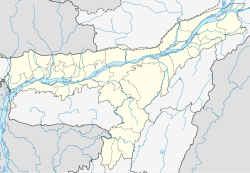Jorhat City
| Jorhat | |
|---|---|
| Location in Assam | |
| Coordinates: 26°45′N 94°13′E / 26.75°N 94.22°ECoordinates: 26°45′N 94°13′E / 26.75°N 94.22°E | |
| Country | India |
| State | Assam |
| Region | Upper Assam |
| District | Jorhat |
| Zone | 3 (Central, East & West) |
| Ward | 19 |
| Jorhat Municipal Board | 1909 |
| Government | |
| • Body | Jorhat Municipal Board |
| • Deputy Commissioner | Viranda Mittal, IAS |
| Area | |
| • Total | 9 km2 (3 sq mi) |
| Elevation | 116 m (381 ft) |
| Population | |
| • Total | 153,259 |
| • Density | 2,851/km2 (7,380/sq mi) |
| Languages | |
| • Official | Assamese, Hindi, English |
| Time zone | IST (UTC+5:30) |
| PIN | 785001 |
| Telephone code | 0376 |
| Vehicle registration | AS-03 |
| Literacy | 89.42 (2011)% |
| Legislature type | Municipality |
| Lok Sabha constituency | 1 |
| Vidhan Sabha constituency | 1 |
| Planning agency | 1 |
Jorhat (pron: ˈʤɔ:(r)ˌhɑ:t)// is a major city and one of the important urban centres of the state of Assam in India. Jorhat is one of the fastest growing cities of Assam after Guwahati.
Guwahati and Jorhat are underway to become two sunshine cities of Assam as declared by the central government.
It was the last capital of the Ahom Kingdom and home to many historical monuments of Assamese culture. In the north of the district, the Brahmaputra River forms the second largest riverine island of the world, Majuli, which spreads over 924.6 square kilometres with a population of about 150,000. The island, threatened with constant erosion by the mighty and unstable Brahmaputra River, had been the principal place of pilgrimage of Vaishnavites since the age of the Ahom rulers. Several Sattras (monasteries) resembling those of medieval times are headed by Satradhikars teaching Vaishnavism, which was introduced by Srimanta Sankardeva (1449–1568). Each Sattra has an unknown wealth of Vaishnavite scriptures and extensive revenue-free lands cultivated by the Bhakats (celebated monks) of the Sattras. The cultural diversities which prevailed in Jorhat nearly a century ago has inspired the people to participate in cultural activities through the decades and as a result Jorhat has been able to produce many creative writers, musician, actors, historians and journalists, terming Jorhat as "The Cultural Capital of Assam".
Jorhat was the first city of the Upper and central Assam installing electricity supply in 1923. The first aeroplane on north-eastern soil was landed in Jorhat in 1928. Jorhat Gymkhana Club is the oldest golf course in Asia and third oldest in the world. The first stadium of Assam was built in Jorhat. The world's oldest and largest Tea Experimental Station is located in Jorhat. The first non-government college of Assam J.B. College was established in Jorhat. Home to the research institutes, such as the , NEIST, Rain Forest Research Institute, Central Muga Eri Research & Training Institute, and universities like Assam Agricultural University, Assam Women's University, Jorhat is a developing region of Assam and the North-east India. In recent times, Jorhat has seen the rise of quite a few apartment complexes with influx of people from different parts of the state.
...
Wikipedia


